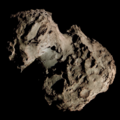10P/Tempel
 Comet Tempel 2 photographed by H. M. Jeffers from the Lick Observatory in 1946[1] | |
| Discovery | |
|---|---|
| Discovered by | Wilhelm Tempel |
| Discovery date | 4 July 1873 |
| Designations | |
| P/1873 N1, P/1878 O1 | |
| |
| Orbital characteristics[3][4] | |
| Epoch | 5 May 2025 (JD 2460800.5) |
| Observation arc | 130.78 years |
| Number of observations | 5,700 |
| Aphelion | 4.710 AU |
| Perihelion | 1.417 AU |
| Semi-major axis | 3.064 AU |
| Eccentricity | 0.53738 |
| Orbital period | 5.362 years |
| Inclination | 12.027° |
| 117.80° | |
| Argument of periapsis | 195.50° |
| Mean anomaly | 276.53° |
| Last perihelion | 24 March 2021 |
| Next perihelion | 2 August 2026[2] |
| TJupiter | 2.965 |
| Earth MOID | 0.410 AU |
| Jupiter MOID | 0.622 AU |
| Physical characteristics[3][5] | |
| Dimensions | 10.6 km (6.6 mi) |
| 8.948±0.001 hours | |
| 0.022 | |
| Comet total magnitude (M1) | 14.3 |
10P/Tempel, also known as Tempel 2, is a periodic Jupiter-family comet with a 5-year orbital period. It was discovered on 4 July 1873 by Wilhelm Tempel.[6] At the perihelion passage on 2 August 2026 the solar elongation is calculated at 164 degrees, with apparent magnitude approximately 8,[2] with closest approach to Earth on 3 August 2026 at a distance of 0.414 AU (61.9 million km).[3]
| Date & time of closest approach |
Earth distance (AU) |
Sun distance (AU) |
Velocity wrt Earth (km/s) |
Velocity wrt Sun (km/s) |
Uncertainty region (3-sigma) |
Reference |
|---|---|---|---|---|---|---|
| 2026-Aug-03 20:59 ± 1 min | 0.414 AU (61.9 million km; 38.5 million mi) | 1.42 AU (212 million km; 132 million mi) | 6.5 | 31.0 | ± 204 km | Horizons |
Physical characteristics
[edit]The comet nucleus is estimated to be roughly the size of Halley's Comet at 10.6 kilometers in diameter with a low albedo of 0.022.[3] The nucleus is dark because hydrocarbons on the surface have been converted to a dark, tar like substance by solar ultraviolet radiation. The nucleus is large enough that even near aphelion (furthest distance from the Sun which is near the orbit of Jupiter) the comet remains brighter than about magnitude 21.

During the 2010 apparition the comet brightened to about apparent magnitude 8.[2] The most favorable apparition of 10P/Tempel 2 was in 1925 when it came within 0.35 AU (52 million km; 33 million mi) of Earth with an apparent magnitude of 6.5.[6][7]
Infrared spectroscopy conducted in July 2010 revealed the presence of CH
3OH, C
2H
6, NH
3 and HCN in trace amounts within its coma, with their peak intensities suggesting a possible existence of a distributed source that was released from the nucleus as sublimed icy grains.[8]
Proposed exploration
[edit]The Jet Propulsion Laboratory proposed a flyby of the comet with a flight spare of Mariner 4.[9] The probe was instead used for a Venus flyby as Mariner 5.[9]
10P/Tempel was to be the target of the NASA part of the International Comet Mission after transporting a European probe to a flyby of Halley's Comet.[10] The plan was to use Solar electric propulsion to get the craft to orbit the comet.[11] The program was cancelled in November 1979.[11]
References
[edit]- ^ F. L. Whipple (1981). On Observing Comets for Nuclear Rotation (PDF). Modern Observational Techniques for Comets Conference Proceedings.
- ^ a b c S. Yoshida (27 January 2008). "10P/Tempel 2". www.aerith.net. Retrieved 24 February 2010.
- ^ a b c d e "10P/Tempel 2 – JPL Small-Body Database Lookup". ssd.jpl.nasa.gov. Jet Propulsion Laboratory. Retrieved 24 February 2010.
- ^ "10P/Tempel Orbit". Minor Planet Center. Retrieved 6 August 2023.
- ^ D. G. Schleicher; M. M. Knight; S. E. Levine (2013). "The Nucleus of Comet 10P/Tempel 2 in 2013 and Consequences Regarding its Rotational State: Early Science from the Discovery Channel Telescope". The Astronomical Journal. 146 (5): 137–145. arXiv:1309.2944. Bibcode:2013AJ....146..137S. doi:10.1088/0004-6256/146/5/137. S2CID 55337675.
- ^ a b G. W. Kronk. "10P/Tempel 2". Cometography.com. Retrieved 24 February 2010.
- ^ a b G. van Biesbroeck (1926). "On the Appearance of the Comets in 1925 from Observations at the Yerkes Observatory". Popular Astronomy. 34: 224–228. Bibcode:1926PA.....34..224V.
- ^ L. Paganini; M. J. Mumma; B. P. Bonev; G. L. Villanueva; et al. (2012). "The formation heritage of Jupiter Family Comet 10P/Tempel 2 as revealed by infrared spectroscopy". Icarus. 218 (1): 644–653. arXiv:1201.5166. Bibcode:2012Icar..218..644P. doi:10.1016/j.icarus.2012.01.004. S2CID 106398196.
- ^ a b P. Ulivi; D. M. Harland (2007). Robotic Exploration of the Solar System Part I: The Golden Age 1957–1982. Springer. pp. 57–58. ISBN 978-0-387-49326-8.
- ^ N. Calder (1992). Giotto to the Comets. Presswork. pp. 25–28. ISBN 0-9520115-0-6.
- ^ a b D. W. Hughes (2006). "The Giotto-Halley 20th anniversary". Astronomy and Geophysics. 47 (1): 1.27 – 1.28. Bibcode:2006A&G....47a..27H. doi:10.1111/j.1468-4004.2006.47127.x. ISSN 1366-8781. S2CID 122044809.
External links
[edit]- 10P/Tempel at the JPL Small-Body Database
- Elements and Ephemeris for 10P/Tempel – Minor Planet Center
- 10P/Tempel 2 / 2010 – Seiichi Yoshida @ aerith.net
- 10P/Tempel 2 (2010) (astrosurf)





